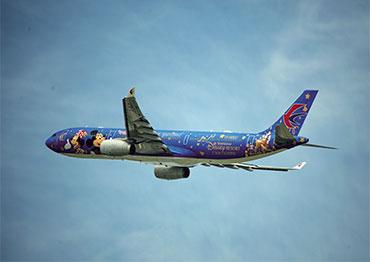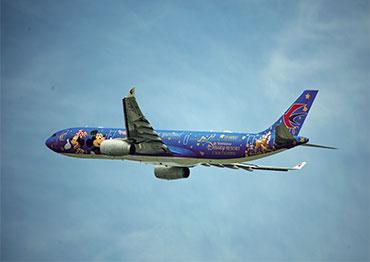Pilot Pan Xiaoliang told NewsChina that he has been working for an airline company for over 10 years. Following the Covid-19 outbreak in early 2020, he was transferred from international passenger to cargo planes. In May 2020, he started piloting international cargo flights after flying to the UK to bring back stranded Chinese nationals when international passenger flights to the Chinese mainland were largely suspended.
In March 2020, to better control the spread of Covid from overseas, China only allowed one airline company, whether domestic or foreign, to operate one route per country, with only one flight a week at most. Many airlines continue to fly only once a week between major international and mainland cities on international routes. Almost all inbound direct international flights to Beijing were suspended, with airlines instead landing in other cities where passengers had to quarantine before being allowed to travel to the capital. This resulted in a sharp decline in international passenger flights. Cargo transportation was less affected. In order to increase the efficiency and revenue of planes, airline companies increased cargo flights and transferred passenger plane personnel to cargo flights. Some even transformed passenger planes into makeshift cargo planes.
According to annual statistics published by the CAAC in May, the aviation industry transported 7.32 million tons of cargo in 2021, a rise of 8.2 percent year-on-year, among which the amount of freight transportation increased by 19.6 percent year-on-year.
But the increase in cargo flights can hardly make up for losing passengers, aviation expert Li Xiaojin said. Even though the profit margin of air cargo doubled during the pandemic, its share of total revenue is low, less than 20 percent for most airlines, with passenger flights earning the bulk of income. China Eastern Airlines, for example, saw air cargo revenues rise from 3.17 percent in 2019 to 11.37 percent in the first quarter of 2021. But passenger flights still accounted for 82.01 percent of total revenue.
In pulling through the tough times, some airlines tried other ways to explore new markets and reduce costs. Cao Zhigui, marketing director of Guangzhou-based 9 Air Company Limited, a subsidiary of Juneyao Airlines, pays close attention to the latest Covid control measures and bailout policies looking for profitable new routes. “Competition for the existing market grew fiercer because of the pandemic. Instead of joining the price wars, we put more efforts into finding new markets,” Cao told NewsChina.
In early June, the Xinjiang Uygur Autonomous Region offered policies to stabilize economic growth, including preferential policies for tourism, which Cao regards as “very beneficial for local tourism development.” On June 10, 9 Air started its first flight from Guangzhou to Turpan. For the summer holidays, the company will operate flights to other cities in the region, including Altay, Yining and Shihezi, and increase flights to regional capital Urumqi. Since most travelers to Xinjiang are tourists, 9 Air has partnered with hotels to provide packages.
In 2021, 9 Air launched over 20 new routes. The first budget airline in central and southern China was the only one of 35 domestic airline companies that stayed in the black in 2021, when the whole industry lost 84.3 billion yuan (US$12.5b).
After surveying 35 airlines, CAAC concluded that even though these companies vary in scale and profit-making models, they all show high flexibility in management philosophy and mechanism, and they do better in taking precise measures to increase income and reduce costs.
“Small and medium companies and budget airlines in smaller cities are less affected. Compared to big airlines with high debt-to-asset ratios, these companies cope with market changes more flexibly. Regional aviation enjoys subsidies from the government, which also helps them reduce costs and increase efficiency,” Li Xiaojin said.
Airline companies in difficulty are getting creative when it comes to lifting themselves out of the doldrums, including livestream sales. In 2020, Spring Airlines started selling tickets and fuselage advertising on livestreaming platforms. In June, China Eastern Airlines offered a flight pass for unlimited travel (with conditions) in the second half of 2022 for 3,322 yuan (US$491). Chinese airlines offered similar flight passes in 2020 and 2021 to kick-start travel.
On May 16, Hainan Airlines crew, taking advantage of Hainan’s duty-free shopping policies, sold skin care and makeup products all night, earning 1.53 million yuan (US$226,134) in a day, a record since the company started livestream sales in April. In July 2022, Hainan Airlines even offered Japanese and French language training classes and seven-day summer camps for children to learn aviation knowledge and survival skills.
Airports, which also suffered big losses during the pandemic, are striving to find more sources of income outside aviation. In 2021, Zhunyi Airport in Guizhou Province, raised 390 million yuan (US$57.6m) through new services like putting charging points in its parking lots, machine maintenance and selling local agricultural products with their big clients.
In May, the CAAC and the Ministry of Finance announced cash subsidies for Chinese airlines between May 21 and July 20 when average daily numbers of domestic flights per week are lower or equal to 4,500 flights. Companies whose average load factors are below 75 percent of normal and whose revenue could not cover variable costs would be covered by the policy. The maximum subsidy was set at 24,000 yuan (US$3,547) per hour.
“It [24,000 yuan] is enough to make up the variable cost of flights [including fuel, labor and airport charges]. In other words, they won’t lose money if they don’t have a single passenger,” Li Xiaojin said. But as the aviation market gradually recovered, the subsidies grew less necessary. On June 4, flights exceeded the minimum 4,500, which led to the subsidy’s suspension between June 4-10.

 Old Version
Old Version


